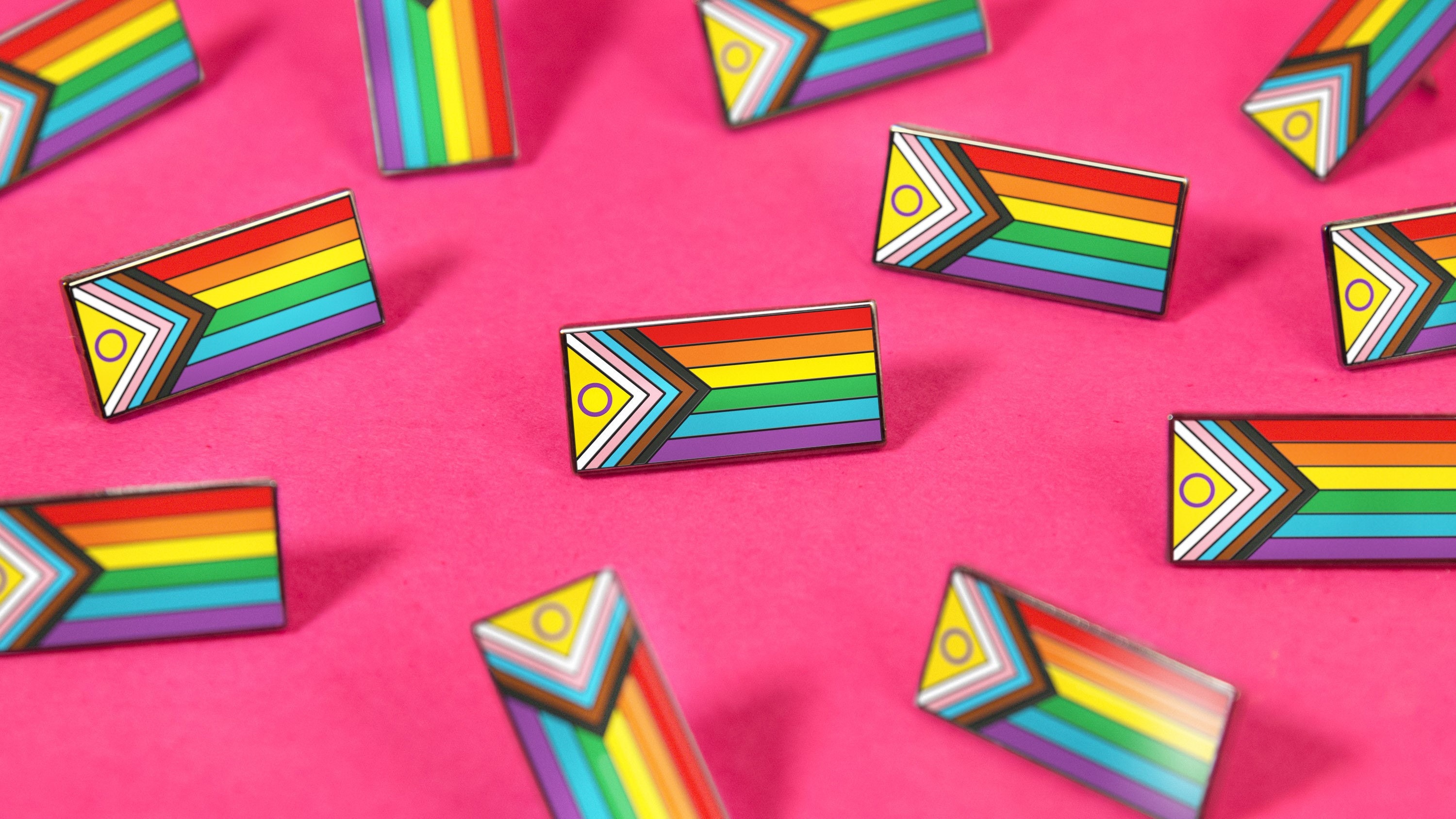The rainbow flag has a rich history, evolving over time to become a symbol of unity, love, and acceptance for the queer community. Rainbow flags are now synonymous with Pride Month and queer rights — and we love to see it!
But where did this flag come from, and how did it become such an icon of the queer community? And what do all the different variations of the rainbow flags mean? Which is the "correct" flag to use? Is there even a "correct" flag?
We'll take a look at the history of the rainbow pride flags, exploring their origins and significance. From the traditional rainbow flag to the more recent additions of the Philadelphia Pride Flag, the Progress Pride Flag, and the Intersex-Inclusive Progress Pride Flag, we'll delve into the meaning behind each one, and help you decide which one best represents you.
Read on as we discover the coloruful history of the rainbow flag and its journey to becoming the iconic symbol of hope for the LGBTQ+ community!
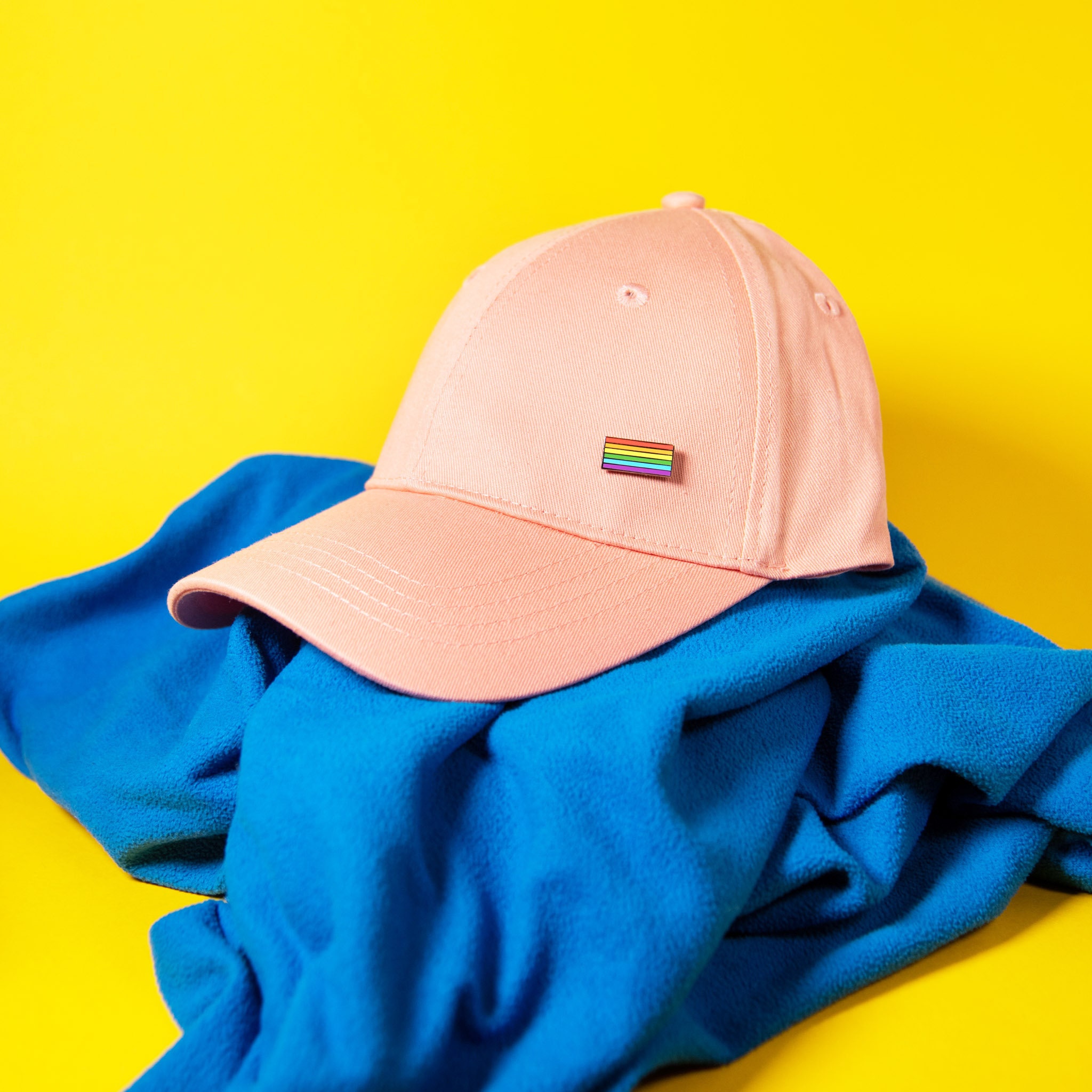
Gilbert Baker’s Rainbow Flags (1978 to 1979)
The first rainbow flag can be traced back to 1978, when artist Gilbert Baker, an openly-gay man and drag queen, designed the very first rainbow flag. It all began when Harvey Milk, one of the first openly-gay elected officials in the United States, urged Baker to create a symbol of pride for the gay community.
Baker believed that flags were the most powerful symbols of pride, and saw the rainbow as a natural flag from the sky. With this, the rainbow found its first use as a symbol for the LGBTQ+ community.
Baker’s first version of the flag had eight colours in its stripes, each with its own unique meaning: hot pink represented sex, red represented life, orange represented healing, yellow represented sunlight, green represented nature, turquoise represented art, indigo represented harmony, and violet represented spirit.
The first of these rainbow flags were flown on June 25, 1978 for the San Francisco Gay Freedom Day parade. (Fun fact: thirty volunteers hand-dyed and stitched the first flags for the parade!)
Following the tragic assassination of Harvey Milk on November 27, 1978, there was a significant increase in demand for the rainbow flag. Baker dropped the hot pink stripe because fabric in that colour was not readily available for mass-production. A year later, the flag was modified again, further dropping the turquoise stripe in favour of an even number of stripes. This resulted in the iconic six-striped flag we know today, featuring red, orange, yellow, green, blue, and violet stripes.

The iconic 6-striped rainbow pride flag. 𝗧𝗵𝗲 𝗥𝗮𝗶𝗻𝗯𝗼𝘄 𝗙𝗹𝗮𝗴 𝗘𝗻𝗮𝗺𝗲𝗹 𝗣𝗶𝗻 by The Pin Prick.
.
This is now the most common version of the rainbow flag, with the red stripe at the top, just like in a natural rainbow. The different colours of the flag came to reflect the diversity and unity of the LGBTQ+ community.
Worth also mentioning: The Rainbow Pride Flag is only six stripes. The (weather) rainbow, when drawn as an illustration, has seven! The indigo stripe doesn't exist on the Pride Flag, so don't accidentally make this faux pas. Once your eyes are trained to differentiate these rainbows, you'll have fun identifying ignorant designers that accidentally (or maybe intentionally?) feature six-striped rainbows that inadvertently rep the Pride Flag colours!
Addendum: In early 2017, Gilbert Baker revealed his "final" version of the rainbow flag. This version was created in response to the election of Donald Trump, and it included an additional ninth stripe in lavender (above the hot pink stripe) to represent diversity within the LGBTQ+ community. However, the 6-striped version of the flag still remains the most popular of his designs.
When should I use the Rainbow Pride Flag?
The 6-striped rainbow pride flag is a widely recognized symbol for the LGBTQ+ community, and is a global symbol of the LGBTQ+ community. The flag can be used in any context where LGBTQ+ representation is desired, such as at pride parades, LGBTQ+ events, or as a symbol of support for the community. The traditional rainbow flag is considered to be the "safest" choice, and has absolutely no capacity to offend or misrepresent. It represents the entire LGBTQ+ community equally, without drawing special attention to any particular queer-minority group, as the later flags do.
.
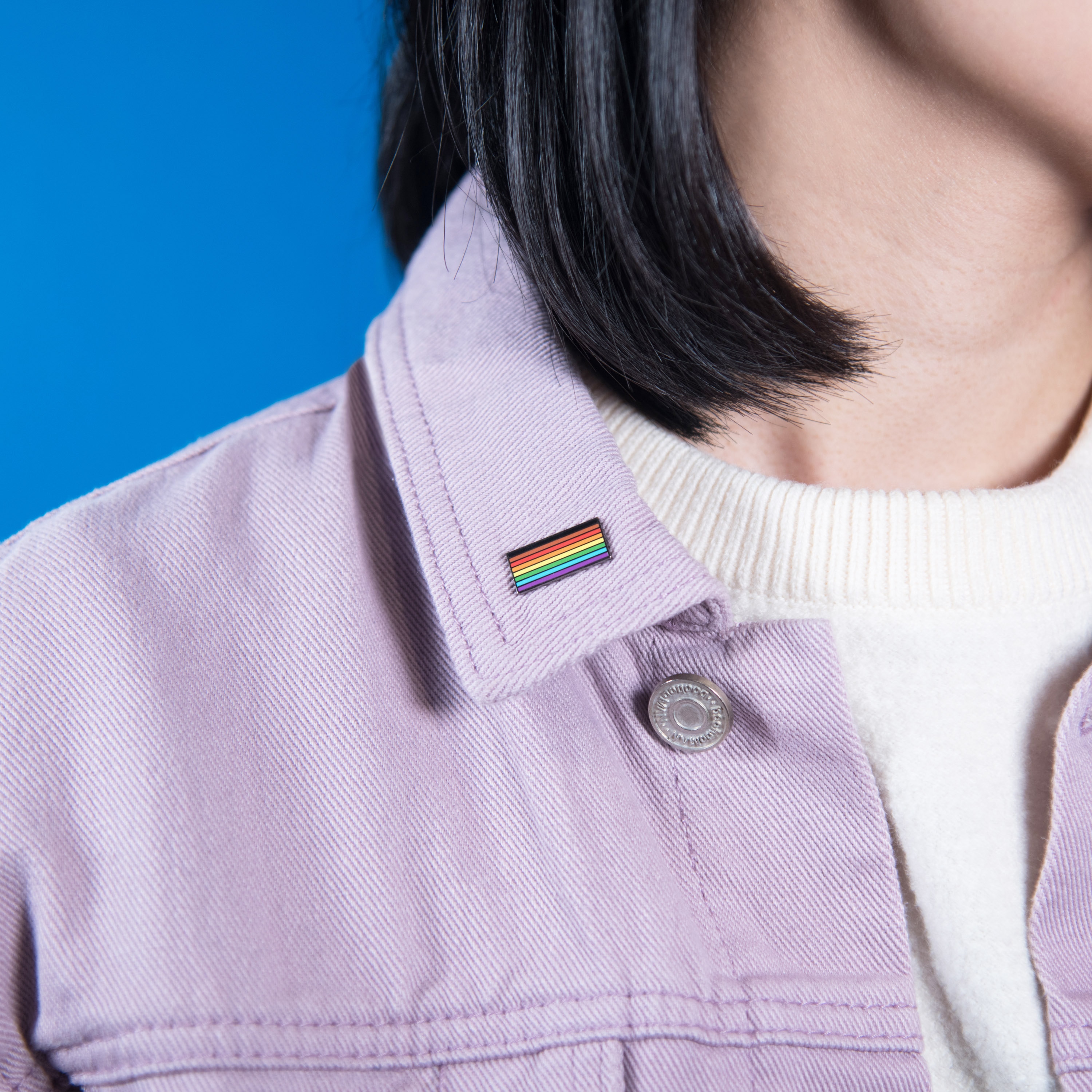
The Philadelphia Pride Flag (2017)
Also known as: The Philly Pride Flag / The Inclusive Pride Flag / The POC Pride Flag / The Black-and-Brown Striped Rainbow Flag / The Intersectional Pride Flag
The Philadelphia Pride Flag is a variation of the 6-striped rainbow flag, designed in 2017 by the city of Philadelphia. The flag features a black and brown stripe on the top of the flag, to represent the marginalized communities within the LGBTQ+ community, particularly the black and brown members of the LGBTQ+ community.
The flag builds upon the "traditional" 6-striped rainbow flag, and also includes the original flag's rainbow colours of red, orange, yellow, green, blue, and purple.
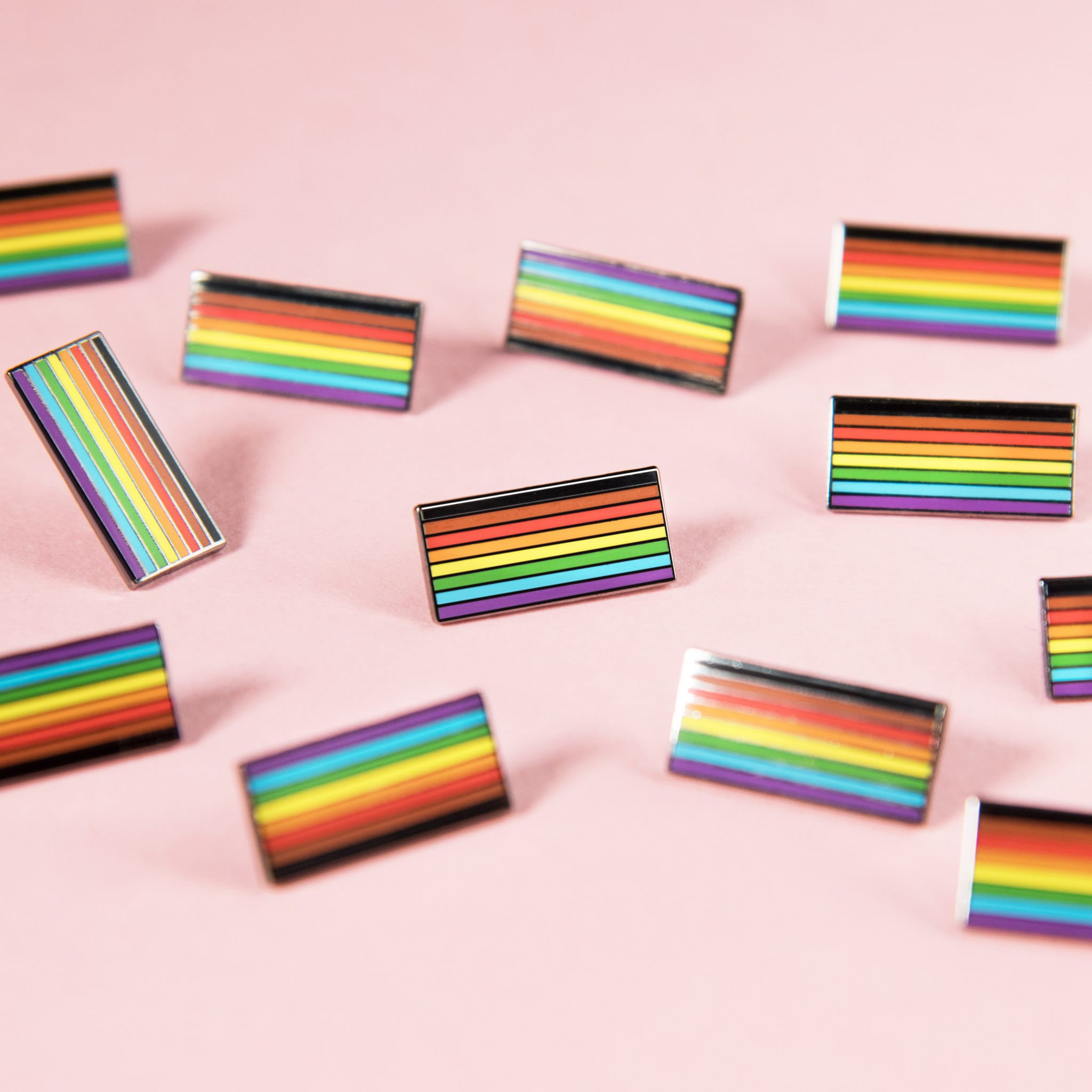
The Philadelphia Pride Flag adds a black and brown stripe to the rainbow flag. 𝗧𝗵𝗲 𝗜𝗻𝗰𝗹𝘂𝘀𝗶𝘃𝗲 𝗥𝗮𝗶𝗻𝗯𝗼𝘄 𝗙𝗹𝗮𝗴 𝗘𝗻𝗮𝗺𝗲𝗹 𝗣𝗶𝗻 by The Pin Prick.
.
According to the Philadelphia Office of LGBT Affairs’ More Color More Pride campaign, the Philadelphia Pride Flag is intended to be a more inclusive symbol that recognises and honours the racial diversity within the LGBTQ+ community, drawing particular attention to the intersectionality of queer and racial issues.
To give context as to why this change was proposed, the Philadelphia's addition of the two stripes came amidst a spate of complaints of racial discrimination in the city's gay bars. The flag was originally intended as a Philadelphia-specific flag, as a response to the social issues the city was then facing.
The redesign of the flag was met with positive reactions from many, particularly of members of the black and brown LGBTQ+ community, who felt that they were finally being represented and seen. It was a powerful symbol of protest that recognized the intersectionality of queerness and race, and showed that the LGBTQ+ community was actively working towards inclusion and representation for all.
The flag resonated with many beyond Philadelphia as well, and its use quickly went viral worldwide, particularly in countries where black and brown people also experienced discrimination. In the years since, it has been used in designs and pride parades around the world, with many people, organisations, and businesses celebrating and welcoming the idea of a "more inclusive" pride symbol.
Criticism and Controversies of the Philadelphia Pride Flag
Philadelphia's desire to be more inclusive towards non-white LGBTQ+ people came with good intentions. However, the flag was met with some controversy. Historically, the rainbow flag has represented the LGBTQ+ community as a whole, and critics of Philadelphia's changes to the flag believe that these changes were not necessary, as the original flag already symbolised unity.
Others argued that the original colours of the flag represented shared experiences of life, while the new colours focussed on specific racial communities instead. The additional stripes may be seen as a divisive move, rather than an inclusive one, as it “otherised” and separated the community by specifically highlighting certain racial groups.
It's worth noting that the redesign of the rainbow flag, specifically the inclusion of black and brown stripes to represent Black and Latino queer communities, comes from a Western/American-centric perspective. While addressing issues of racial discrimination within the LGBTQ+ community in Philadelphia is certainly relevant, and can be extrapolated to other countries as well, it's important to recognize that this perspective is not global. In other parts of the world, the issues faced by black and brown members of the LGBTQ+ community may not be the same (don’t forget: a “racial minority” in your country isn’t the same in every country!), and the symbolism of these stripes may not hold the same significance.
While the intentions behind Philadelphia's redesign of the rainbow flag were to make it more inclusive for non-white LGBTQ+ people, it's important to consider different global perspectives, and to understand the flag’s origins and intentions. Ultimately, you will be the one to decide if this version of the rainbow flag holds the most significance to the issues and beliefs that are important to you!
When is the Philadelphia Pride Flag appropriate to use?
The Philadelphia pride flag can be used to show support for marginalized communities within the LGBTQ+ community, particularly in support of Black and Latino queer communities.
This flag may be particularly appropriate in contexts where issues of racism and discrimination within the LGBTQ+ community are being addressed or discussed. For example, if an organization is specifically working on issues faced by black and brown members of the LGBTQ+ community, the Philadelphia pride flag could be used as a symbol of support for that work.
This flag has particular relevance in countries where black and brown people are racial minorities that experience discrimination, which may not be the same experience for all communties across the world. It is also important to be mindful that in some contexts, the use of this flag may be seen as pandering towards black/brown racial minorities if the meaning of the flag’s design is not fully understood by the bearer.
.

The Progress Pride Flag (2018)
Also known as: The Progress Rainbow Flag, The Trans-Inclusive Rainbow Pride Flag, The Intersectional Pride Flag
Introduced in June 2018 by Daniel Quasar, the flag redesign builds upon the 2017 Philadelphia Pride Flag, which added a black and a brown stripe to the original 6-striped rainbow flag.
The Progress Pride Flag is intended to be an even more inclusive symbol that represents marginalized communities within the LGBTQ+ community — notably black and brown people, people affected by HIV/AIDS, and the transgender community.
The brown stripe on the Progress Pride Flag continues to represent marginalised people of colour (POC), while the black stripe has been added to represent those who have been lost to HIV/AIDS or those who continue to live with it. The blue, pink and white stripes of the Transgender Pride Flag are included as well, to represent the transgender community.
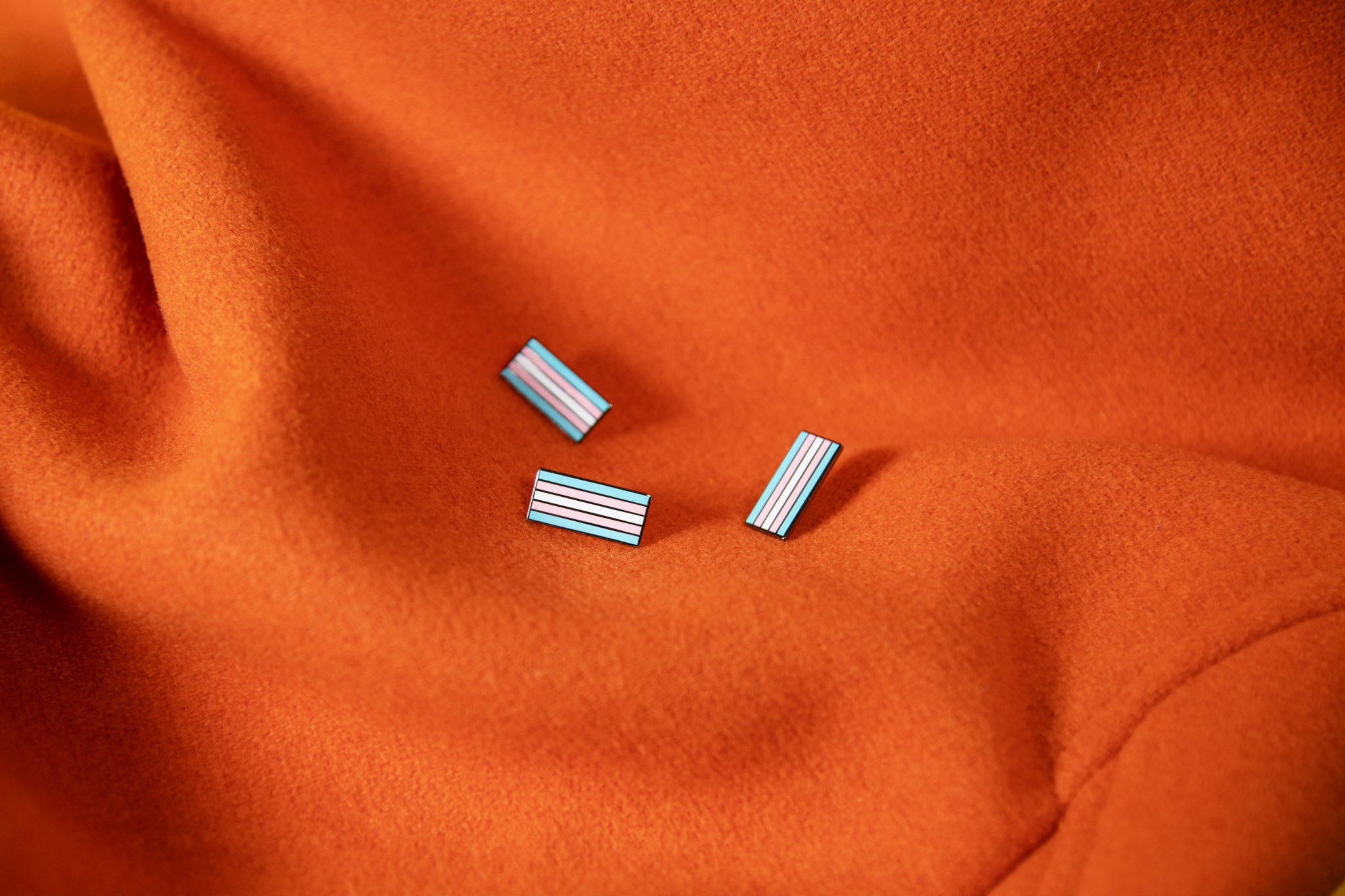
The Transgender Pride Flag features five stripes, from top to bottom: blue, pink, white, pink and blue. 𝗧𝗵𝗲 𝗧𝗿𝗮𝗻𝘀𝗴𝗲𝗻𝗱𝗲𝗿 𝗙𝗹𝗮𝗴 𝗘𝗻𝗮𝗺𝗲𝗹 𝗣𝗶𝗻 by The Pin Prick
.
The forward-pointing chevron on the hoist of the flag, symbolises the forward movement and progress that still needs to be made to achieve equality and end discrimination. The placement of the chevron on the left represents the progress that still has to be made.
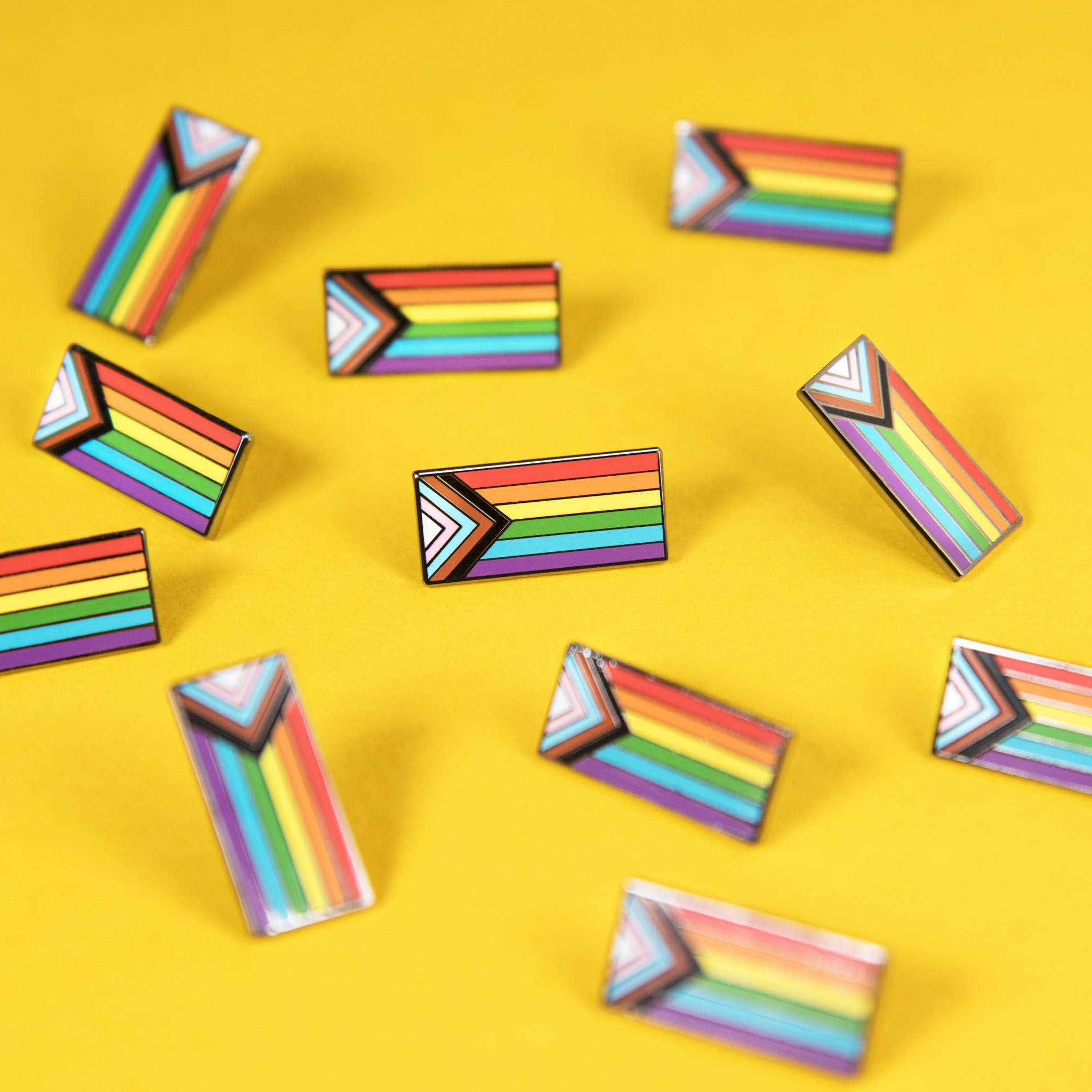
The Progress Pride Flag further adds a chevron to represent transgender communities. 𝗧𝗵𝗲 𝗣𝗿𝗼𝗴𝗿𝗲𝘀𝘀 𝗣𝗿𝗶𝗱𝗲 𝗙𝗹𝗮𝗴 𝗘𝗻𝗮𝗺𝗲𝗹 𝗣𝗶𝗻 by The Pin Prick.
Quasar hoped that his design would place greater emphasis on inclusion and progression, as well as adding more layers of meaning to the rainbow flag. He emphasized that progress needs to always be moving forward in all aspects of the LGBTQ+ community.
Criticism and Controversies of the Progress Pride Flag
When the Progress Pride Flag was first introduced, it faced some criticisms similar to those that the Philadelphia Pride Flag had received.
Some critics argued that the original 6-striped rainbow flag already served as a universal symbol to unite all queer people, and that the inclusion of additional symbols to represent specific communities visually separated them from the larger LGBTQ+ community.
However, the designer, Daniel Quasar, and other supporters of the Progress Pride Flag stated that it was not meant to replace the original flag, but rather to serve as an additional symbol that recognizes and represents marginalized communities within the LGBTQ+ community.
The Progress Pride Flag is most often used in contexts where issues of intersectionality and allyship are being discussed, especially if transgender issues are being addressed.

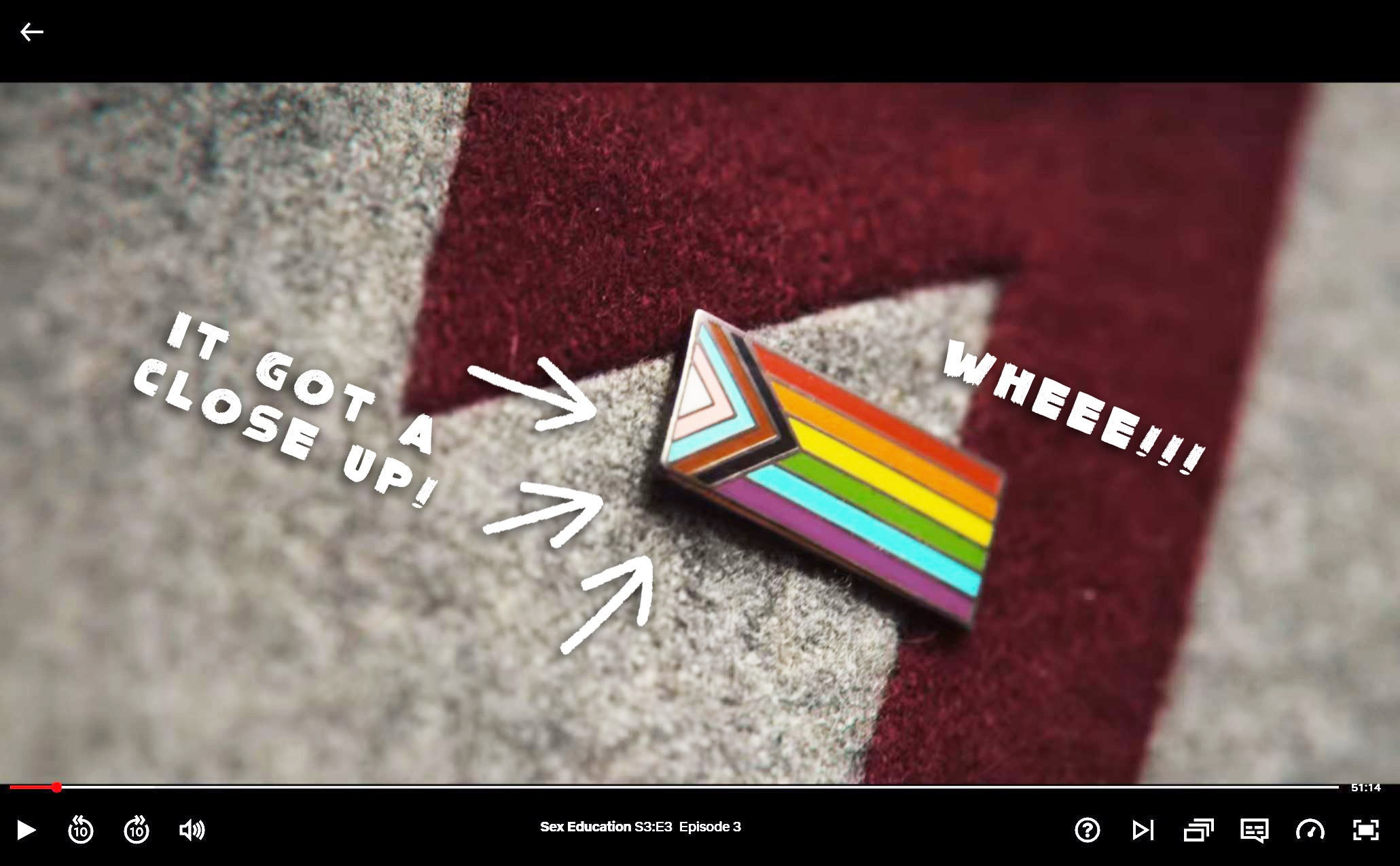

My Progress Pride Flag enamel pin was worn by Ola in Netflix's Sex Education! 𝗧𝗵𝗲 𝗣𝗿𝗼𝗴𝗿𝗲𝘀𝘀 𝗣𝗿𝗶𝗱𝗲 𝗙𝗹𝗮𝗴 𝗘𝗻𝗮𝗺𝗲𝗹 𝗣𝗶𝗻 by The Pin Prick.
Should I use the Progress Pride Flag?
The Progress Pride Flag is a symbol of the ongoing movement towards social progress and equality for the LGBTQ+ community. This relatively "new" flag demonstrates an understanding of the recent issues and movements within the LGBTQ+ community.
It is appropriate to use in contexts where issues of intersectionality and allyship are being discussed, such as in organizations working on issues faced by the transgender community or focused on intersectional LGBTQ+ rights. This flag is also popular in healthcare, school and social-work settings to visually communicate safe spaces, particularly highlighting the inclusion of trans and nonbinary individuals.
This design seems particularly popular with the younger generations who have come of age alongside the design of this flag.
If you are an organisation looking to use this version of the flag for a campaign or pride event, it is important that your cause aligns with the flag's intentions and meaning: to be a vector for the better representation of trans, HIV/AIDS-affected, and black/brown racial minorities within the LGBTQ+ community.
.
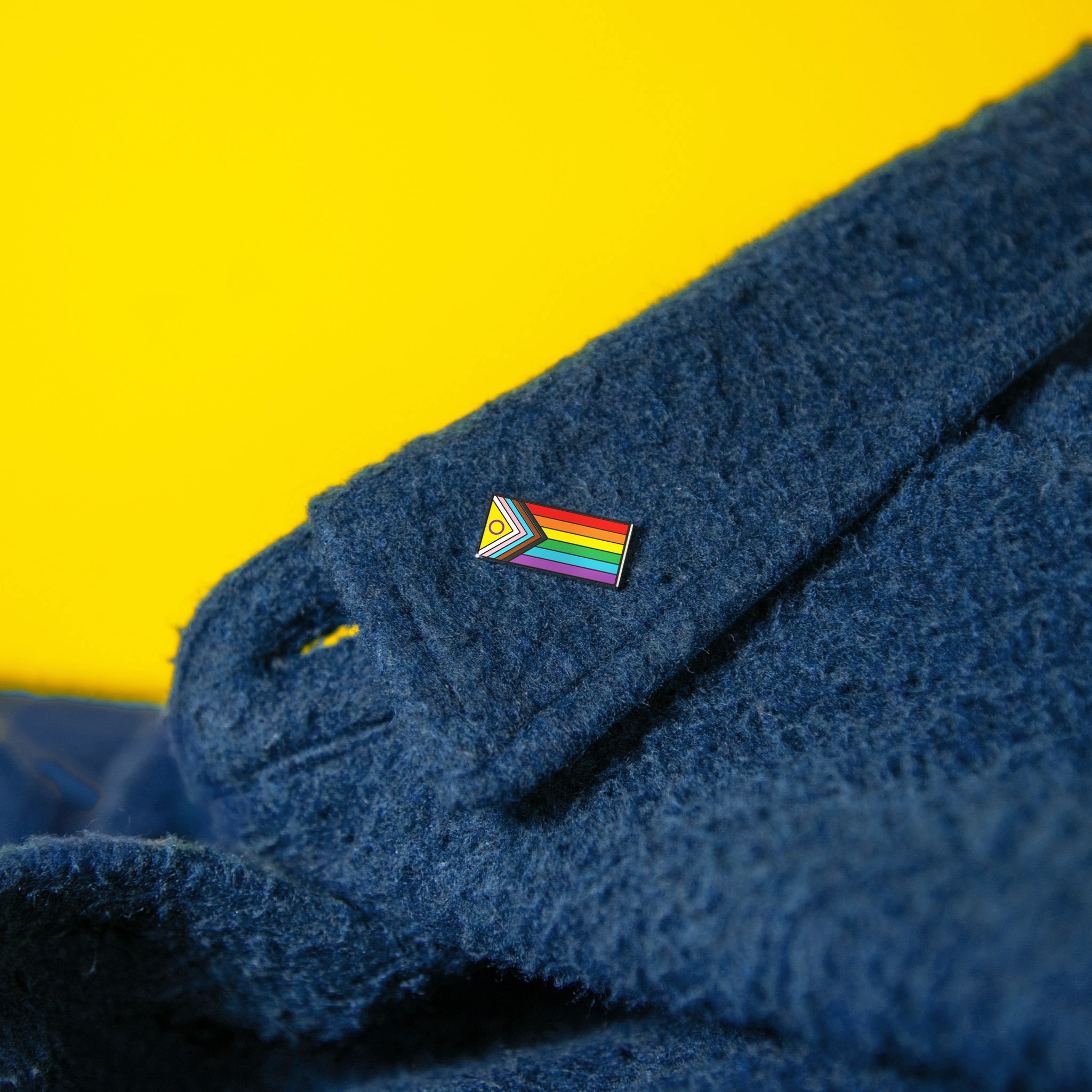
The Intersex-Inclusive Progress Pride Flag (2021)
Also known as: The Intersex Rainbow Pride Flag (Not to be confused with the Intersex Pride Flag)
Designed by Valentino Vecchietti and unveiled by Intersex Equality Rights UK in 2021, the Intersex-Inclusive Progress Pride Flag adds a purple circle on a yellow triangle to symbolise the intersex community.
Intersex is a term used to describe individuals who are born with physical, hormonal, or genetic characteristics that do not fit typical definitions of male or female. It is important to note that being intersex is not a medical condition that requires “fixing”, as it is a natural variation in the biology of human beings. Intersex people are diverse in their identities, and may identify as male, female, or nonbinary – or may not identify with any gender at all.
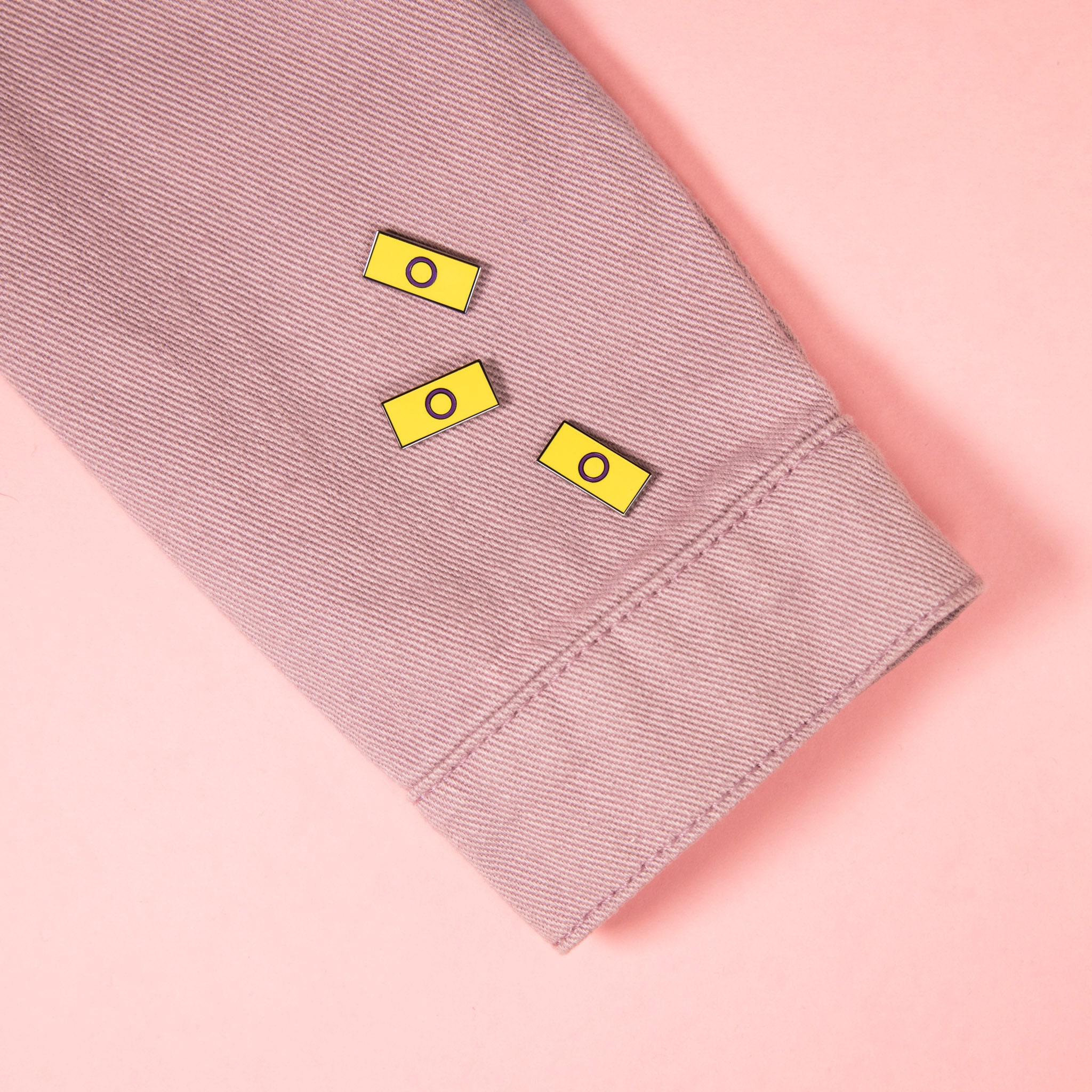
The Intersex Pride Flag features a purple circle in the centre of a yellow background. 𝗧𝗵𝗲 𝗜𝗻𝘁𝗲𝗿𝘀𝗲𝘅 𝗣𝗿𝗶𝗱𝗲 𝗙𝗹𝗮𝗴 𝗘𝗻𝗮𝗺𝗲𝗹 𝗣𝗶𝗻 by The Pin Prick.
.
The Intersex-Inclusive Progress Pride Flag design builds on the 2018 Progress Pride Flag, which had added the 5-striped chevron to the flag’s hoist. This in turn was an update of the 2017 Inclusive/Philadelphia Pride flag, which had added the brown and black stripes to the 6-striped Rainbow Flag.
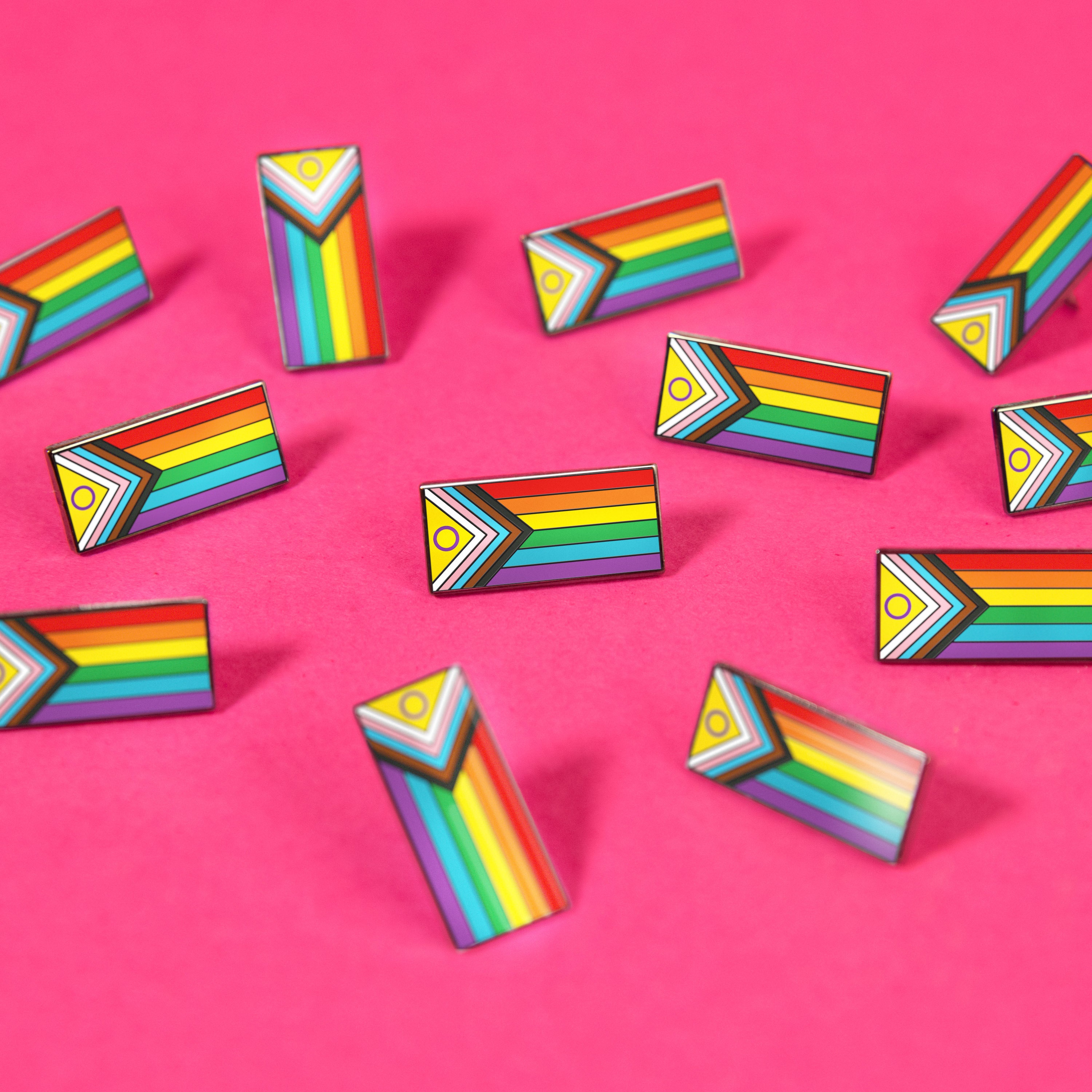
𝗧𝗵𝗲 𝗜𝗻𝘁𝗲𝗿𝘀𝗲𝘅-𝗜𝗻𝗰𝗹𝘂𝘀𝗶𝘃𝗲 𝗣𝗿𝗼𝗴𝗿𝗲𝘀𝘀 𝗣𝗿𝗶𝗱𝗲 𝗙𝗹𝗮𝗴 𝗘𝗻𝗮𝗺𝗲𝗹 𝗣𝗶𝗻 by The Pin Prick
.
The newest addition of the intersex symbology hoped to bring visual representation of intersex people to the rainbow flag. Intersex people have historically been underrepresented within the queer community, and this flag fought against this.
The Intersex-Inclusive Progress Pride Flag reflects the ongoing effort to make the LGBTQ+ community more inclusive, and to help the unseen feel seen. This update to the flag has experienced particular uptake within the UK, most notably during 2022 London Pride, when the Intersex-Inclusive Progress Pride Flags were used to adorn Regent Street to celebrate Pride Month.
Criticism and Controversies of the Intersex-Inclusive Progress Pride Flag
And – as I’m sure you’re sensing a pattern here – those for and against the design for the new updated flag held similar opinions as before: that more representation within the rainbow flag is never a bad thing – or on the flip side – that adding more symbols to represent specific groups created divisions within the community.
However, it is understood that these new versions of the flag do not supersede the previous, and that everyone is able to choose which versions of the flags best represent them.
When should I use the Intersex-Inclusive Progress Pride Flag?
The Intersex-Inclusive Progress Pride Flag includes an additional symbol of support for the intersex community and the issues they face. This flag is particularly appropriate for use in contexts where intersex issues are discussed, such as in LGBTQ+ healthcare settings.
This flag is particularly popular in the UK, where it was initially debuted, but has been growing in global online popularity over social media.
But hey – don't blindly use this version of the flag just because it's new and "woke" to do so! Make it a point to learn why the flag is bringing specific attention to the issues of intersex, transgender, HIV/AIDS-affected, and black/brown racial minorities, in order to fly this flag with the fullest understanding of its meaning.
.
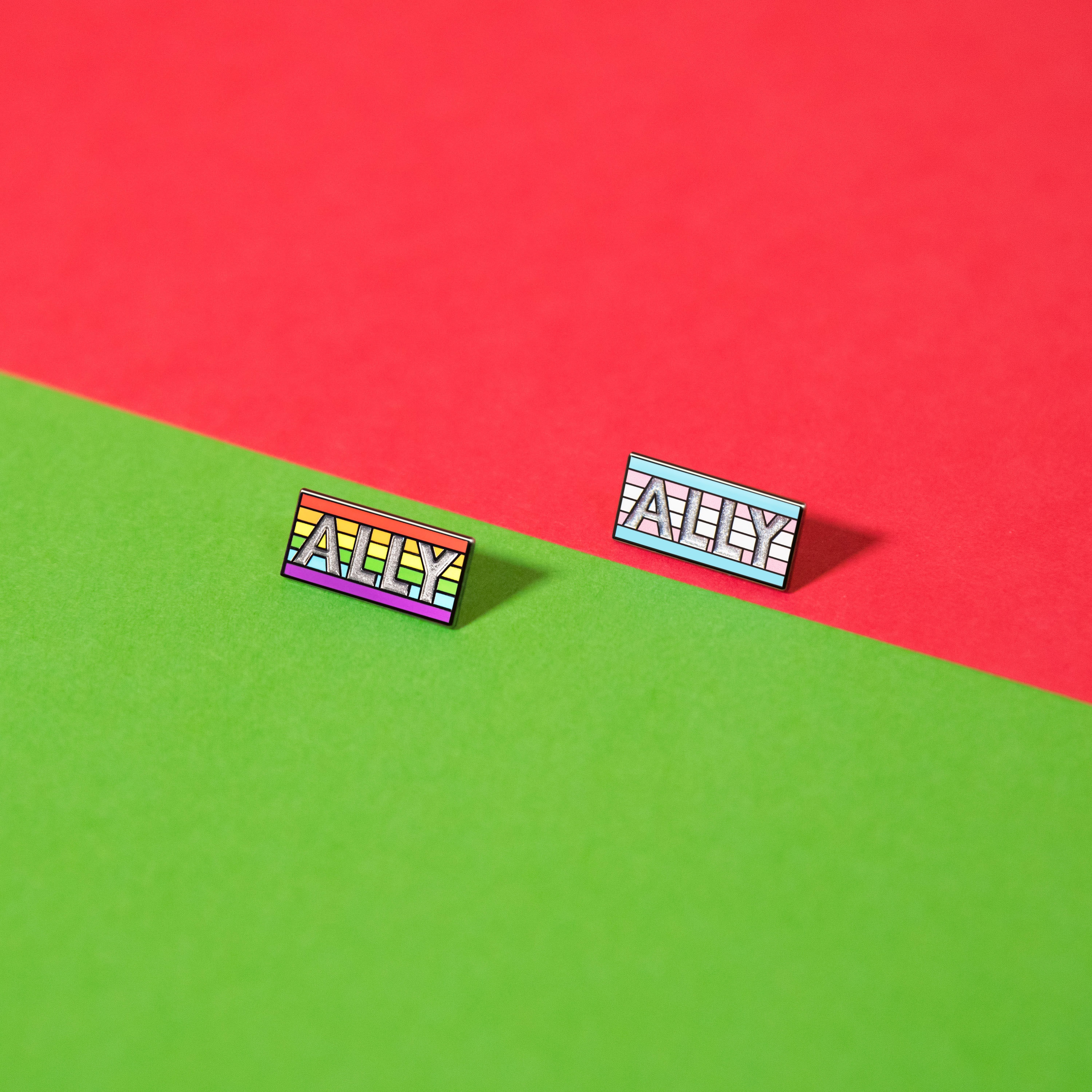
Looking to rep some support for your LGBT+ community? 𝗧𝗵𝗲 𝗥𝗮𝗶𝗻𝗯𝗼𝘄 𝗮𝗻𝗱 𝗧𝗿𝗮𝗻𝘀 𝗔𝗟𝗟𝗬 𝗘𝗻𝗮𝗺𝗲𝗹 𝗣𝗶𝗻𝘀 by The Pin Prick
.
Which Rainbow Flag is the “best“ or “correct” one for me to use?
With the number of recent updates to the Rainbow Pride Flag, I get this question a lot – and it is very heartening that it always comes from a good place. Most people are worried to accidentally offend or mis-represent the rainbow flag, and understandably so!
First and foremost, it is important to understand that any form of rainbow flag representation is always welcomed. To a queer person, seeing someone earnestly displaying a rainbow flag will never be taken as offensive, but rather as a positive and important way to create visible safe spaces.
The key is to keep in mind that the flag is a symbol of unity and inclusivity, and it is important to use it in a way that aligns with these values.
However, if you're unsure of which version of the flag to use for an event, or to send to a friend as a gift, here are a few pointers that summarise what each flag best stands for:
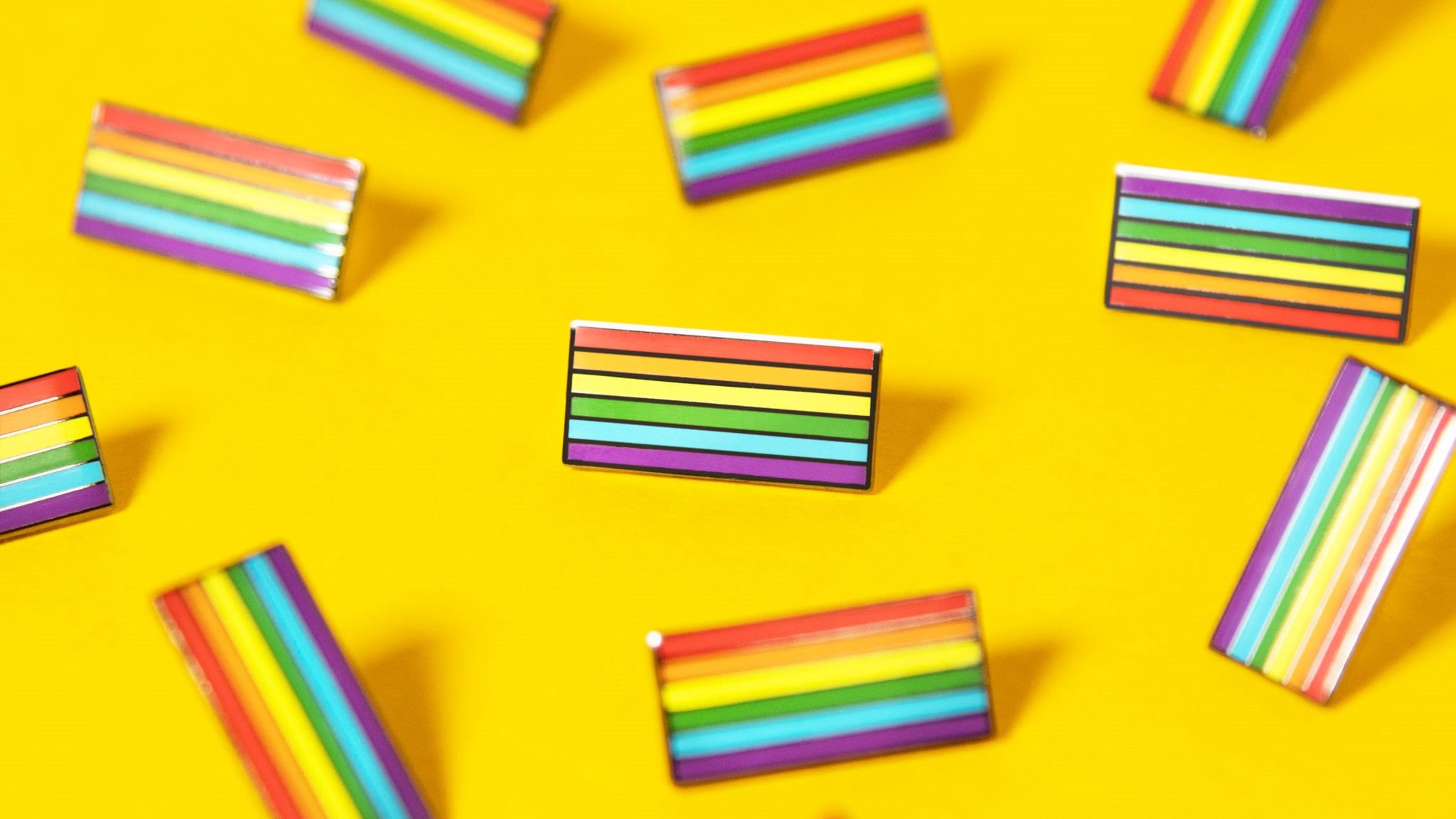
The Rainbow Pride Flag
The most recognisable 6-striped rainbow flag
- Global relevance
- Most recognisable symbol for the LGBTQ+ community
- Can be used in any context where LGBTQ+ representation is desired, such as at pride parades, LGBTQ+ events, or as a symbol of support for the community
- The “safest” choice, and has absolutely no capacity to offend or misrepresent – unless maybe if you accidentally fly the flag upside down! Remember: Red's on top, the first colour – just like in the rainbow! ROYGBIV / Roy G. Biv / "Richard of York Gave Battle in Vain" – whatever mnemonic it takes to help you remember!
- Worth also mentioning: The Rainbow Pride Flag is only six stripes. The (weather) rainbow has seven! The indigo stripe doesn't exist on the Pride Flag.
- Represents the entire LGBTQ+ community equally, without drawing special attention to any particular group
- Maintains relevance in countries and cultures where black and brown people are not racial minorities that experience discrimination
.
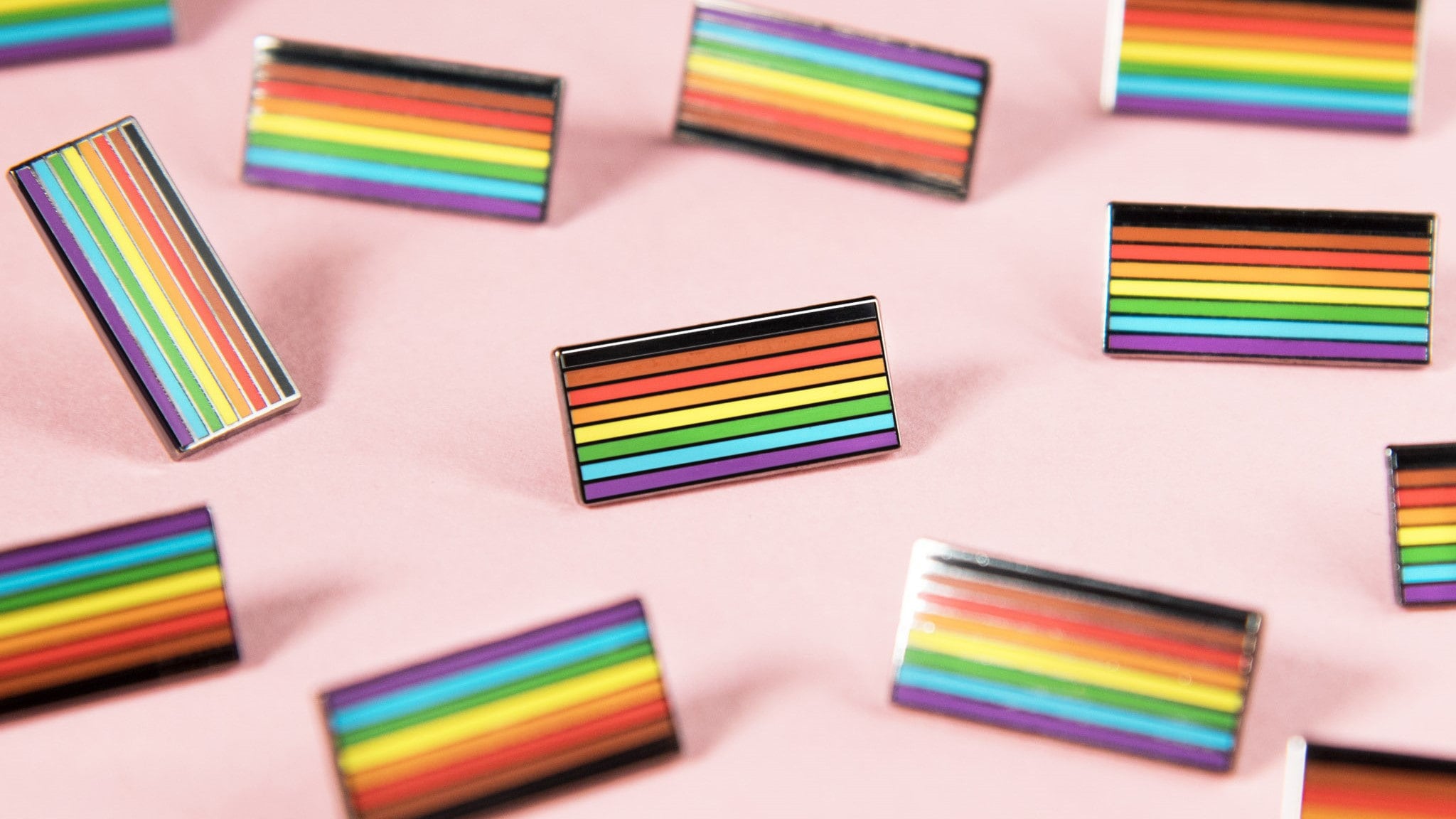
The Philadelphia/Inclusive Pride Flag
The version which added black and brown stripes to the 6-striped flag
- Can be used to show support for marginalized communities within the LGBTQ+ community, particularly Black and Latino queer communities
- Appropriate in contexts where issues of racism and discrimination within the LGBTQ+ community are being addressed or discussed
- Has particular relevance in countries where black and brown people are racial minorities that experience discrimination
- First found popular usage in the USA, before spreading to other countries (often with white majorities)
- In certain circles, the use of the black and brown stripes to represent black and brown people through their skin colour was thought to be distasteful and too literal in symbology
- May be seen as pandering towards black/brown racial minorities, if the meaning of the flag’s design is not understood by the bearer
- Remember: this flag does not replace any preceeding designs, but adds to the vocabulary of different flags we can choose to use — whether individually or alongside others
.

The Progress Pride Flag
The version which further added a transgender chevron to the hoist
- Can be used to show support for the ongoing movement towards social progress and equality for the LGBTQ+ community
- A relatively “new” flag that demonstrates an understanding of the recent issues and movements within the LGBTQ+ community.
- Appropriate in contexts where issues of intersectionality and allyship are being discussed
- Appropriate in contexts where transgender issues are addressed
- Popular in healthcare, school, and social-work settings to visually communicate safe spaces, particularly highlighting the inclusion of trans and nonbinary individuals
- Particularly popular with the younger queer generations who came of age alongside the design of this flag
- May be seen as pandering towards trans, HIV/AIDS-affected, or black/brown racial minorities, if the meaning of the flag’s design is not understood by the bearer
- Remember: this flag does not replace any preceeding designs, but adds to the vocabulary of different flags we can choose to use — whether individually or alongside others
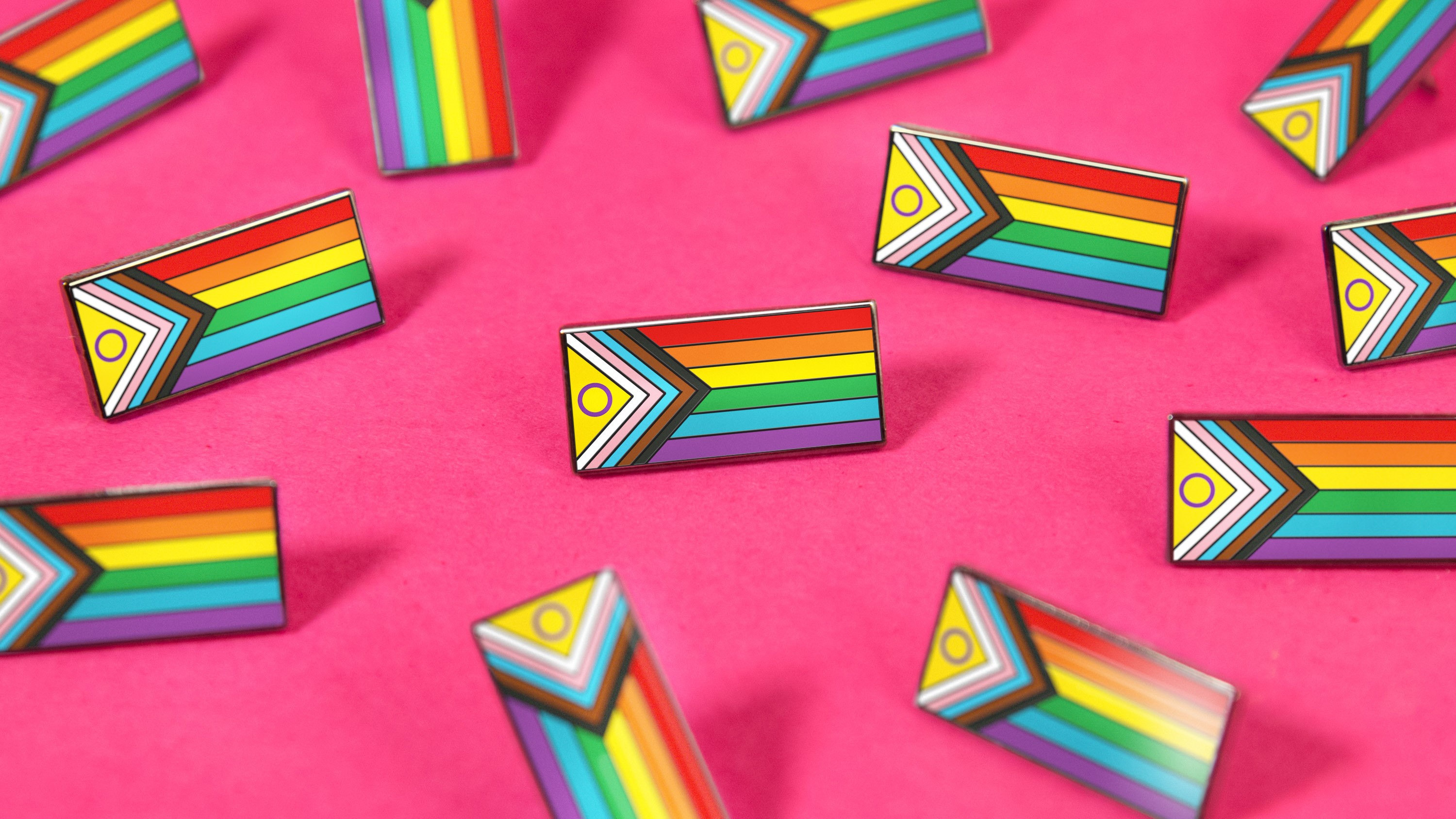
Intersex-Inclusive Progress Pride Flag
The version which further added intersex-pride symbolism
- The most “woke” of the rainbow flags – heh!
- Can be used to show support for the intersex community and to bring visibility to the issues they face
- Appropriate in contexts where intersex issues are being discussed, such as LGBTQ+ events or in healthcare settings
- Particularly popular in the UK, where this flag was initially debuted
- Growing in global online popularity over social media
- May be seen as pandering towards intersex, trans, HIV/AIDS-affected, or black/brown racial minorities, if the meaning of the flag’s design is not understood by the bearer
- Remember: this flag does not replace any preceeding designs, but adds to the vocabulary of different flags we can choose to use — whether individually or alongside others
.
In conculsion
The Pride Flag has always been a fluid symbol, constantly evolving as its community grows, develops, and learns more about itself. It’s always worth remembering that the flags don’t “replace” each other, but rather add to the lexicon of symbols that we can choose to use!
Each version of the flag always strives towards the same purpose: to be ever more inclusive and representative of the different communities within the LGBTQ+ community. These flags are symbols of unity, love, and acceptance, and it is important to that the flags are flown for reasons that align with these values.
Ultimately, you get to decide which flag (or flags!) best represent you.
As always, what matters most is that we all come together to support, love, and accept one another, regardless of our differences. Let us continue to strive for equality, understanding, and inclusivity for all!
.
Wear a Rainbow Flag Pin!
Wearing a pride pin can serve as a way to signal to others that you are an ally (or member!) of the LGBTQ+ community. This can help to create a sense of community and solidarity among LGBTQ+ individuals and their allies and help to build momentum for social change.
Just through a small accessory, we can normalise queer representation and provide opportunites to start important conversations around us!
I am an independent queer designer who has dedicated my time to creating sleek, minimalist pride accessories for all. Classy, subtle and with just the right amount of discreetness, my designs have found their way onto your school uniforms and workplace lanyards - and even on Netflix's Sex Education!
It would mean the world to me if you had a cheeky peek of my online shop - even if just to browse and drive a little traffic to my site! Cheers!
You can find all my designs here at: www.pinprick.shop
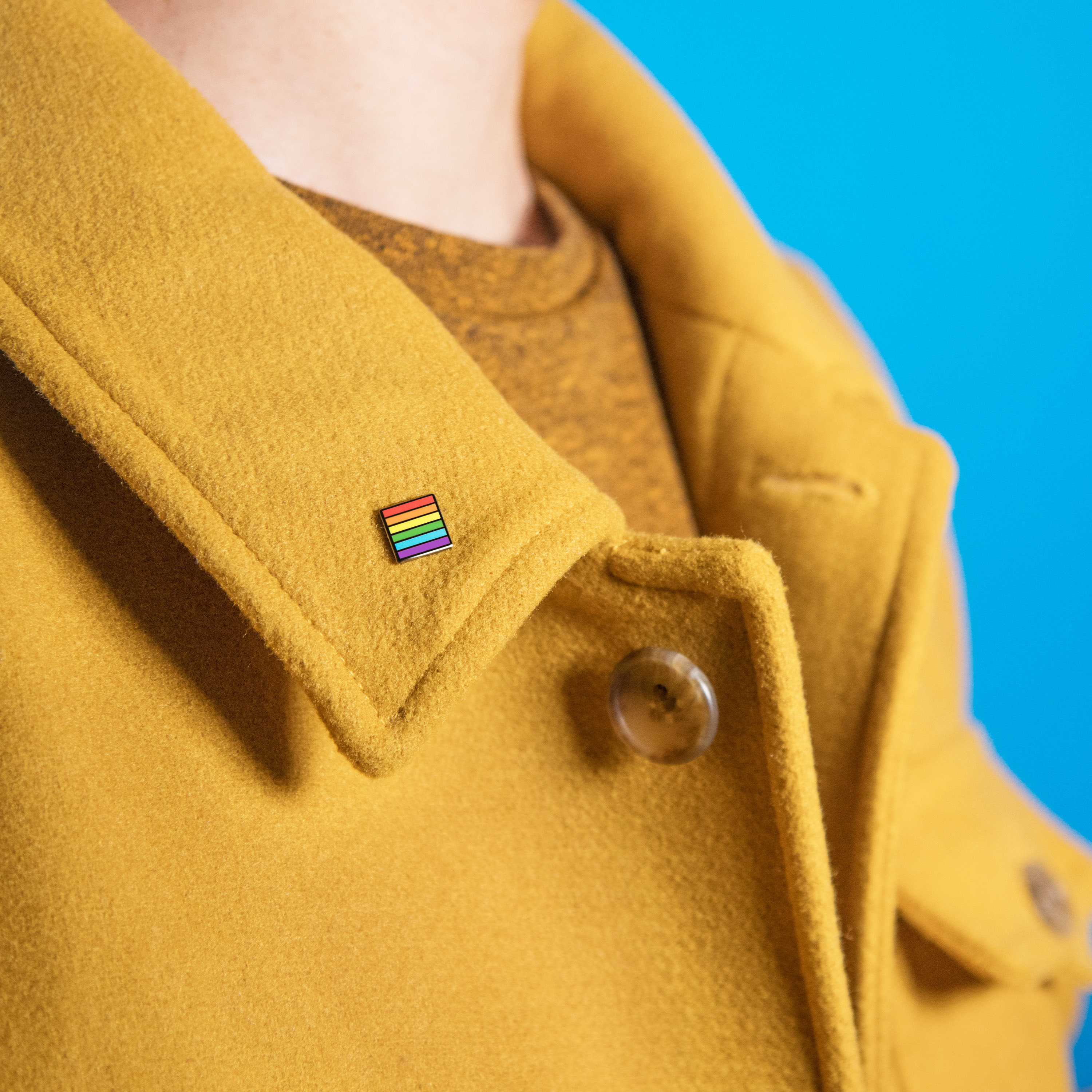
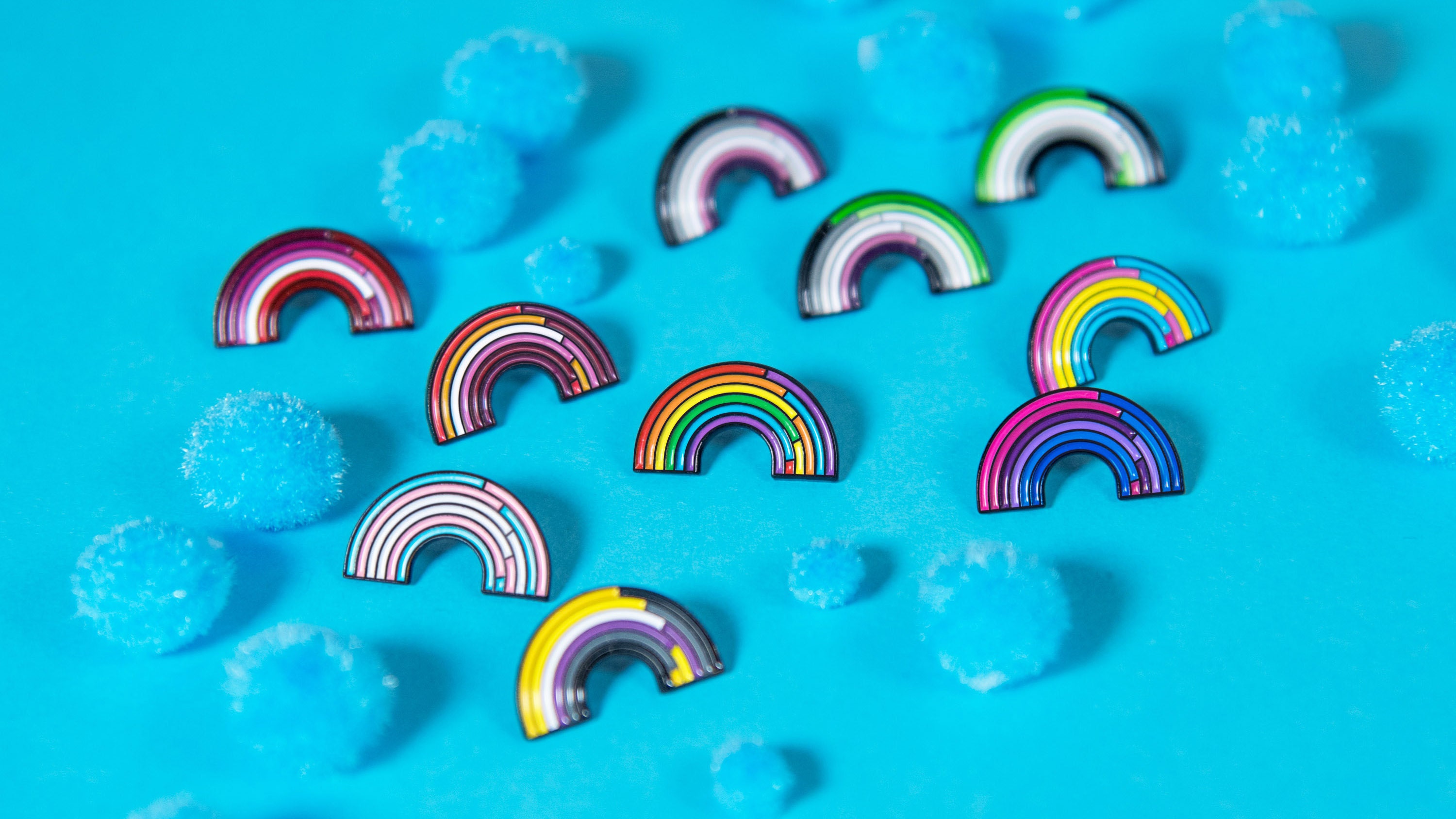
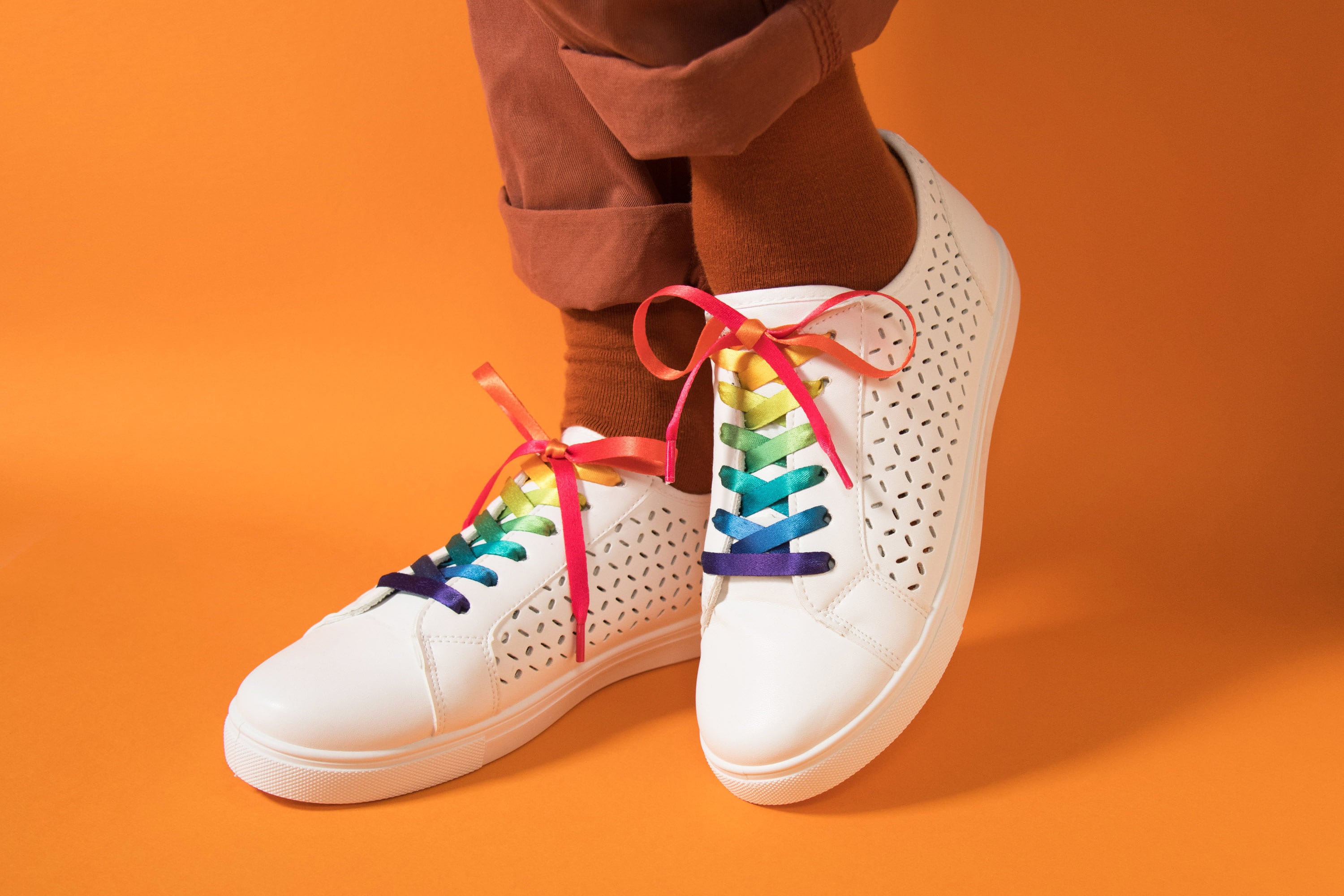


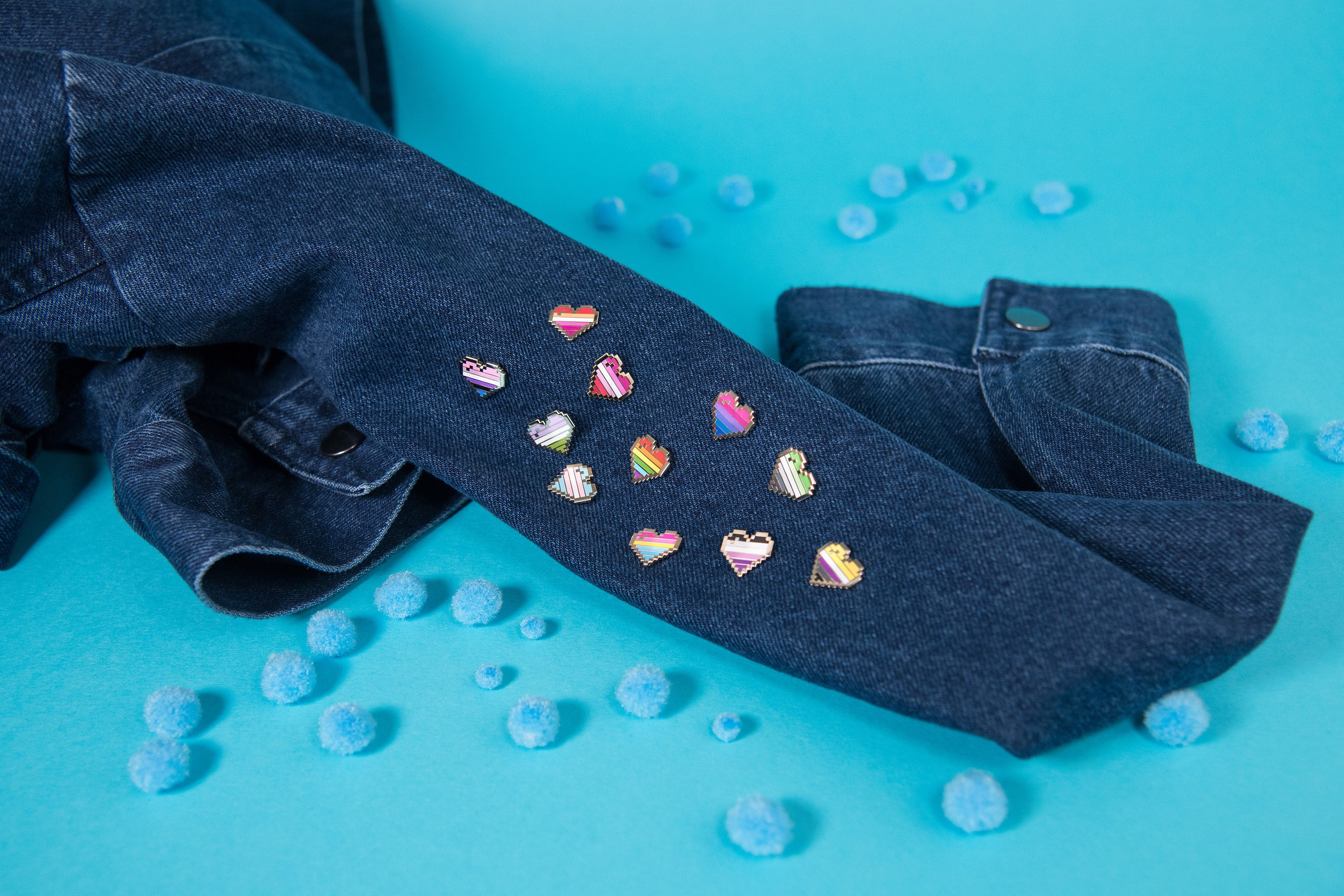
𝗟𝗚𝗕𝗧 𝗣𝗿𝗶𝗱𝗲 𝗛𝗲𝗮𝗿𝘁 𝗣𝗶𝗻𝘀 𝗯𝘆 𝗧𝗵𝗲 𝗣𝗶𝗻 𝗣𝗿𝗶𝗰𝗸

